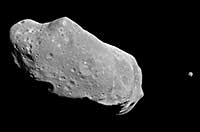|
COMETS EARTH JUPITER KUIPER BELT MARS MERCURY METEORITES NEPTUNE OORT CLOUD PLUTO SATURN SOLAR SYSTEM SPACE SUN URANUS VENUS ORDER PRINTS
PHOTO CATEGORIES SCIENCEVIEWS AMERICAN INDIAN AMPHIBIANS BIRDS BUGS FINE ART FOSSILS THE ISLANDS HISTORICAL PHOTOS MAMMALS OTHER PARKS PLANTS RELIGIOUS REPTILES SCIENCEVIEWS PRINTS
|
Related Document
Download Options
This is the first full picture showing both asteroid 243 Ida and its newly discovered moon to be transmitted to Earth from the National Aeronautics and Space Administration's (NASA's) Galileo spacecraft--the first conclusive evidence that natural satellites of asteroids exist. Ida, the large object, is about 56 kilometers (35 miles) long. Ida's natural satellite is the small object to the right. This portrait was taken by Galileo's charge-coupled device (CCD) camera on August 28, 1993, about 14 minutes before the Jupiter-bound spacecraft's closest approach to the asteroid, from a range of 10,870 kilometers (6,755 miles). Ida is a heavily cratered, irregularly shaped asteroid in the main asteroid belt between Mars and Jupiter--the 243rd asteroid to be discovered since the first was found at the beginning of the 19th century. Ida is a member of a group of asteroids called the Koronis family. The small satellite, which is about 1.5 kilometers (1 mile) across in this view, has yet to be given a name by astronomers. It has been provisionally designated '1993 (243) 1' by the International Astronomical Union. ('1993' denotes the year the picture was taken, '243' the asteroid number and '1' the fact that it is the first moon of Ida to be found.) Although appearing to be 'next' to Ida, the satellite is actually in the foreground, slightly closer to the spacecraft than Ida is. Combining this image with data from Galileo's near-infrared mapping spectrometer, the science team estimates that the satellite is about 100 kilometers (60 miles) away from the center of Ida. This image, which was taken through a green filter, is one of a six-frame series using different color filters. The spatial resolution in this image is about 100 meters (330 feet) per pixel. |
